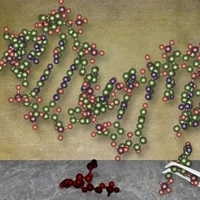Special Charles C. Jones Seminar
In Vivo Genome Editing: from Proof-of-Concept to Therapeutic Delivery with Dr. Hao Yin, Massachusetts Institute of Technology
The CRISPR/Cas9 system has emerged as a transforming genome editing tool. CRISPR/Cas9 genome editing has been applied to correct disease-causing mutations in mouse zygotes and human cell lines, but delivery to adult mammalian organs to correct genetic disease genes has not been reported prior to our study. The liver disease hereditary tyrosinemia type I is a suitable model for gene repair-based therapy because the repaired hepatocytes will expand and repopulate the liver. Mutation of fumarylacetoacetate hydrolase (FAH), the last enzyme catalyzing the tyrosine catabolic pathway, leads to accumulation of toxic metabolites and severe liver damage. The Fahmut/mut mouse model harbors the same homozygous G to A point mutation of the last nucleotide of exon 8 as causes the human disease. This causes splicing skipping of exon 8 and truncated Fah mRNA.
In our first proof-of-concept study, we demonstrate CRISPR/Cas9-mediated correction of the Fah point mutation in hepatocytes in the Fahmut/mut mice. Delivery of the CRISPR/Cas9 system by hydrodynamic injection resulted in initial expression of the wild-type Fah protein in ~1/250 liver cells. Expansion of Fah-positive hepatocytes rescued the body weight loss phenotype. Our study indicates that for the first time CRISPR/Cas9-mediated genome editing is possible in adult animals and has potential for correction of human genetic diseases.
Clinical implementation of CRISPR system requires safe and effective delivery to target tissue. In our second study, we combined lipid nanoparticle—mediated delivery of Cas9 mRNA with adeno-associated viruses encoding a sgRNA and a repair template to induce gene repair in the Fahmut/mut mice. The efficiency of correction was >6% of hepatocytes after a single application with minimal off-target effects, suggesting potential utility of Cas9-based therapeutic genome editing for a range of diseases.
Dr. Hao Yin received his B.S. degree in Biotechnology from Nanjing University in Nanjing, China and completed his PhD training at the School of Pharmacy at the University of Colorado Anschutz Medical Campus. In December 2010, He joined the research group of Professor Robert Langer and Professor Daniel Anderson at Massachusetts Institute of Technology, as a postdoctoral associate. At Langer/Anderson lab, he harnessed novel viral and non-viral delivery vectors and genome engineering technologies for developing gene-based therapy and generating cancer models. He spearheaded the first demonstration that CRISPR can reverse disease symptoms in living animals, extending its application from in vitro to in vivo. His work, published in 2014 in Nature Biotechnology, has been highlighted in front-page headlines and as cover stories by numerous influential public media and scientific journals worldwide. With expertise in non-viral vectors, he generated clinical suitable delivery methods for CRISPR mediated in vivo gene repair. Published in 2016 in Nature Biotechnology, he developed a lipid-based nanoformulation of Cas9 mRNA for in vivo delivery (named as Nano.Cas9). When Nano.Cas9 was combined with an adenovirus-associated virus vector carrying a guide RNA and a repair template, this treatment induced gene repair with high efficiency and minimal off-target genomic effects in the liver. In collaborations with the laboratories of Professor Phillip Sharp and Professor Tyler Jacks, he is the leading author in another landmark study described in Nature, demonstrating that CRISPR can directly mutate tumor suppressor genes and oncogenes in vivo, creating a new avenue for the rapid development of cancer models and functional genomics.
